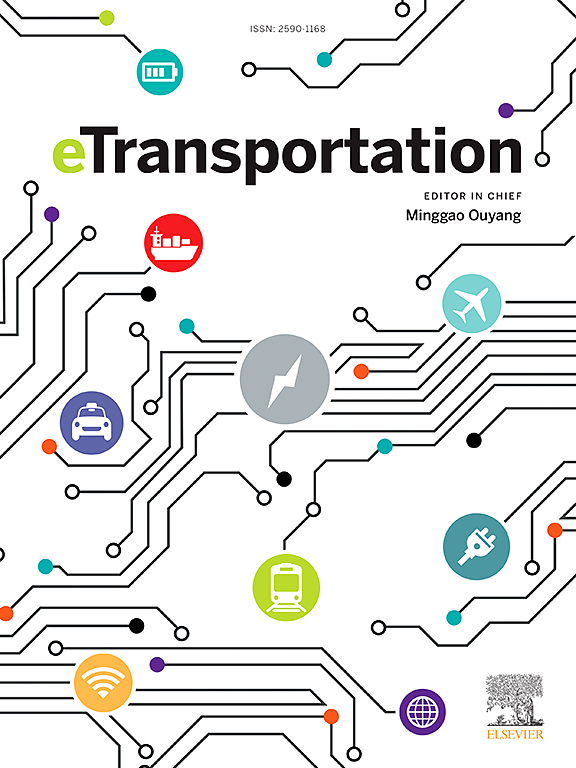High-performance solid-state sodium-ion batteries for lightweight electric vehicles: A closed-loop feedback-optimized composite electrolyte design
IF 17
1区 工程技术
Q1 ENERGY & FUELS
引用次数: 0
Abstract
The composite solid electrolytes integrate the merits of polymers and inorganic materials, which provide a strong guarantee for the safety and stability of solid-state sodium-ion battery systems. In this work, based on the multicomponent synergistic effect in the composite electrolytes, the system composition of the electrolytes was regulated by the closed-loop feedback strategy, and the novel composite solid electrolytes modified by NASICON(Na Super Ionic Conductor) active fillers were constructed, and the sodium ion transport pathways in the system were explored in detail. Meanwhile, N'N-dimethylformamide (DMF) was chosen as the solvent to form [DMF-Na+] as the transport carriers, and the co-allocation competition state between -CN and TFSI- anions enhanced the dissociation process of sodium salts. The introduction of Na3.4Zr1.8Ni0.2Si2PO12 improved the migration ability of sodium ions in the electrolytes, thereby significantly improving the performance of the composite solid electrolytes. The prepared PNS/NZSP-Ni0.2 (PVDF/NaTFSI/SN/Na3.4Zr1.8Ni0.2Si2PO12) electrolytes exhibit high sodium ion conductivity of 1.02 × 10−3 S cm−1 at room temperature. The further assembled Na|PNS/NZSP-Ni0.2|Na3V2(PO4)3 solid-state sodium-ion battery shows excellent cycling stability, with a capacity retention rate of 90 % after 700 cycles at a current density of 0.5C. This work advances the development of safe, high-performance batteries for transportation electrification and grid-scale energy storage, while the closed-loop feedback strategy has been applied for the first time to the optimization of sodium-ion solid electrolytes, overcoming the bottleneck of single-component optimization of electrolytes.

轻型电动汽车用高性能固态钠离子电池:闭环反馈优化复合电解质设计
复合固体电解质综合了聚合物和无机材料的优点,为固态钠离子电池系统的安全性和稳定性提供了强有力的保障。本文基于复合电解质中的多组分协同效应,通过闭环反馈策略调控电解质的体系组成,构建了由NASICON(Na Super Ionic Conductor)活性填料修饰的新型复合固体电解质,并详细探讨了钠离子在体系中的输运途径。同时,选择N'N-二甲基甲酰胺(DMF)作为溶剂形成[DMF- na +]作为运输载体,- cn和TFSI-阴离子的共分配竞争状态增强了钠盐的解离过程。Na3.4Zr1.8Ni0.2Si2PO12的引入提高了电解质中钠离子的迁移能力,从而显著提高了复合固体电解质的性能。制备的PNS/NZSP-Ni0.2 (PVDF/NaTFSI/SN/Na3.4Zr1.8Ni0.2Si2PO12)电解质在室温下钠离子电导率为1.02 × 10−3 S cm−1。进一步组装的Na|PNS/NZSP-Ni0.2|Na3V2(PO4)3固态钠离子电池表现出优异的循环稳定性,在0.5C电流密度下循环700次后容量保持率为90%。本工作推动了安全、高性能的交通电气化电池和电网规模储能电池的发展,而闭环反馈策略首次应用于钠离子固体电解质的优化,克服了电解质单组分优化的瓶颈。
本文章由计算机程序翻译,如有差异,请以英文原文为准。
求助全文
约1分钟内获得全文
求助全文
来源期刊

Etransportation
Engineering-Automotive Engineering
CiteScore
19.80
自引率
12.60%
发文量
57
审稿时长
39 days
期刊介绍:
eTransportation is a scholarly journal that aims to advance knowledge in the field of electric transportation. It focuses on all modes of transportation that utilize electricity as their primary source of energy, including electric vehicles, trains, ships, and aircraft. The journal covers all stages of research, development, and testing of new technologies, systems, and devices related to electrical transportation.
The journal welcomes the use of simulation and analysis tools at the system, transport, or device level. Its primary emphasis is on the study of the electrical and electronic aspects of transportation systems. However, it also considers research on mechanical parts or subsystems of vehicles if there is a clear interaction with electrical or electronic equipment.
Please note that this journal excludes other aspects such as sociological, political, regulatory, or environmental factors from its scope.
 求助内容:
求助内容: 应助结果提醒方式:
应助结果提醒方式:


